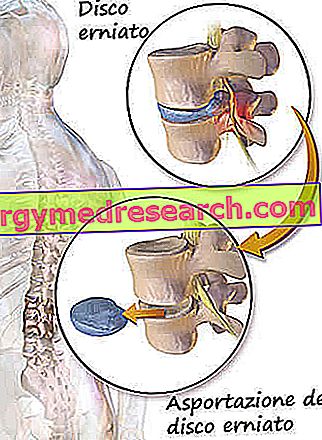Generality
The lips are the outer contours of the mouth.
Soft, mobile and flexible, the lips play a key role in food intake and in the articulation of sounds and words; they also act as a tactile organ, contribute to facial expression and represent a very important erogenous zone.

The lips include portions of the skin, skin-mucous coverings and areas of the actual mucosa. Furthermore, they are linked to numerous muscles, are finely innervated and have a dense network of blood vessels.
The lips may develop some characteristic diseases, including the cleft lip, or they may be the site of symptoms (eg cyanosis), deriving from health conditions originating elsewhere.
Definition of lips
The lips (in the singular lip) are the two outer margins of the mouth .
Visible to the naked eye and with a certain tactile sensitivity, the lips are fairly soft, mobile and flexible.
Anatomy
The anatomists distinguish the two lips in the upper lip and the lower lip .
The upper lip is the outer margin of the mouth that covers the upper dental arch and the upper gums; begins just below the nose.
The lower lip, on the other hand, is the outer margin of the mouth that covers the lower dental arch and the lower gums; it is in continuity with the chin.
The upper lip and lower lip are joined where the anatomists identify the so-called corners of the mouth .
The junction points of the two lips, present at the corners of the mouth, are called labial commissures .
The lips include portions of the skin, skin-mucous coverings and areas of the actual mucosa .
The portions of skin and the cutaneous-mucosal coverings - whose specific name of these latter is zones of the vermilion - constitute the anterior part of both lips; the mucosa, instead, represents the inner part .
The lips present a complex system of muscles and are finely innervated and vascularized.
- The skin portions are rich in sweat glands, sebaceous glands and hair follicles. They border on the cutaneous-mucosal linings, from which they are separated by the so-called vermilion border .
Their color is equivalent to that of any area of skin present elsewhere, but they have far fewer layers of cells (2-5 layers, for the skin of the lips, and at least 16 for the skin of a generic point in the human body).
They contain little melanin.
- The cutaneous-mucosal linings (or areas of the vermilion) are a middle ground between the aforementioned cutaneous portions and the internal mucosa. In fact, exactly like the mucosa, they lack sweat glands, sebaceous glands and hair follicles and, in the same way as the skin, are devoid of salivary glands, therefore dry.
To mark the boundaries is the aforementioned border of the vermilion.
To understand what they are, in light-skinned people they correspond to pink-red areas, which surround the mouth and whose size varies from individual to individual.
The characteristic color of the vermilion areas is due to their blood vessels.
- The internal mucosa is very similar to the buccal mucosa, houses a fair number of minor salivary glands, which give it a moist appearance, is smooth and has a dense network of nerves and blood vessels.

UPPER LIP
The cutaneous portion of the upper lip includes that anatomical area situated under the nose, in which a vertical groove is recognizable that seems to continue the nasal septum.
The anatomists identify this vertical groove with the name of median groove or filter and the two lateral ridges, which delimit it, with the term of filter columns .
The portion of skin of the upper lip ends at the edge of the vermilion of the upper lip . The latter has a characteristic arch shape and it is for this reason that it takes the name of Cupid 's bow .
The so-called vermilion zone of the upper lip begins from the Cupid's bow and extends to where the mucosa of the upper lip begins. To characterize the vermilion area of the upper lip is a visible central prominence, which experts in anatomy call the tubercle of the upper lip .
Where the internal mucosa of the upper lip extends, the presence of the so-called upper labial frenulum is noted. The upper labial frenulum is the band of mucous tissue that joins the center of the upper gum to the inner section of the upper lip.
LOWER LIP
The cutaneous portion of the lower lip includes that anatomical area situated above the so - called chin-labial sulcus . The chin-labial sulcus is the characteristic fissure, recognizable a little higher than the chin, which acts as a boundary line between the latter and the lower lip.
Like the cutaneous portion of the upper lip, the portion of the skin of the lower lip ends where the edge of the vermilion of the lower lip stands out. The edge of the vermilion of the lower lip is slightly curved.
From the edge of the vermilion of the lower lip to where the inner mucosa of the lower lip begins, the so-called vermilion zone of the lower lip extends.
Similarly to the internal mucosa of the upper lip, also the internal mucosa of the lower lip has a strip of mucous tissue that connects it, centrally, to the center of the gingiva, in this case, lower. This strip of mucous tissue takes the anatomical name of inferior labial frenulum .
DIMENSIONS
The size of the lips (extensions of the vermilion zones, amplitude, etc.) vary from individual to individual and depend mainly on: the race of belonging and genetic factors.
INNERVATION
Sensory innervation of the lips is the responsibility of the nerves - obviously sensitive - that derive from the maxillary branch and the mandibular branch of the trigeminal nerve .
Specifically, they provide innervate lips:
- The infraorbital nerve . It is a sensitive branch of the maxillary nerve, which, in addition to innervating the upper lip, also innervates the cutaneous portion of face between the upper lip and the lower eyelids of the eyes (NB: the nasal bridge is excluded).
- The mental nerve . It is a sensitive branch of the mandibular nerve. In fact, it is a sensitive branch of the inferior alveolar nerve, which is he the true branch of the mandibular nerve. The job of the mental nerve is to innervate the lower lip and the skin of the chin in general.
vascularization
The inflow of oxygenated blood to the lips belongs to two branches of the facial artery : the branch known as the upper labial artery and the branch known as the lower labial artery .
Remember that the facial artery is one of the 6 branches of the external carotid artery .
MUSCLES
The movement of the lips depends on different muscles.
The muscles that allow the movement of the lips play a fundamental role within the so-called facial mimic (or facial expression ).
Controlled by the branches of the facial nerve ( seventh cranial nerve ), the muscular elements acting on the lips are:
- The buccinator muscle. It works by compressing the cheeks to the teeth, during acts such as blowing. Newborns use it to suck milk.
- The orbicular muscle of the mouth. It is the muscle that serves to tighten the lips when you kiss. For this reason it is also called the kiss muscle .
- The levator muscle of the upper lip, the levator muscle of the nose and lips, the levator muscle of the corners of the mouth, the minor zygomatic muscle and the major zygomatic muscle. All together these muscles provide for the raising of the lips;
- The risori muscle, the depressor muscle of the corner of the mouth, the depressor muscle of the lower lip and the mental muscle.
Function
The lips have various functions. In fact, they are used for food intake and the articulation of sounds and speech, they can act as a tactile organ, they contribute to facial expressions and represent a very important erogenous zone.
LIP AND FEEDING
Lips play a key role in the feeding process. In fact, they allow the human being to introduce solid foods and drinks into the oral cavity, and to prevent them from escaping, by hermetically closing them during chewing.
Furthermore, they make it possible to eliminate unwanted objects, which can be found as ingested.
In neonatal age, lips are essential for sucking milk.
LIPS AND ARTICULATION OF THE WORD AND SOUNDS
In the process of articulating words, the lips allow the human being to emit, principally, the sounds of the labial, bilabial and labiodental consonants.
Moreover, they allow the so-called rounding of vowels . In phonetics, the rounding of vowels refers to the more or less round shape taken by the lips, at the time of the articulation of a vowel.
The lips are also fundamental for the emission of sounds through wind instruments (trumpet, trombone, clarinet, flute, saxophone, etc.).
LIPS AS TACTILE ORGANS
The high number of nerve endings, present on the lips, make the latter of the tactile organs particularly sensitive to hot and cold sensations.
Thanks to their sensitivity, the lips are a means by which small children get to know objects that are still unknown to them.
LIP AND FACIAL MIMICA
The lips allow the expression of feelings, moods etc. contributing to facial expression. Think, for example, of a smile or laughter, which express a state of happiness or good humor.
LIPS AS EROGENE AREAS
Once again, thanks to their high number of nerve endings, the lips are an anatomical area of the human body whose external stimulation is linked to excitement and sexual pleasure (erogenous zone).
Kisses are given with the lips and many other intimacy gestures are exchanged. The lips, therefore, are fundamental elements in the life of relationship of the human being.
Lips and sensuality
The format of the lips is linked to sexual attraction in both men and women.
For example, the researchers noted that medium-sized lips - so neither too large nor too small - make male subjects especially sexually attractive.
Illnesses
The lips can be protagonists of diseases or be the seat of symptoms deriving from pathologies located elsewhere.
Among the diseases of the lips, they certainly deserve a mention: the cleft lip, the episodes of cheilitis and the episodes of carcinoma of the lips.
Regarding the symptoms that can be seen on the lips, on the occasion of certain pathological conditions, the color change of the upper lip and lower lip is noted, following a cyanosis event.
CLEFT LIP
Also known as cleft lip or cleft lip, the cleft lip is a congenital malformation of the lips, more precisely of the upper lip.
In fact, those suffering from cleft lip have one or two incisions on the upper lip, which can extend to the floor of one or both nasal nostrils.

The cleft lip mainly involves difficulty in eating and speaking, dental problems and predisposition to ear infections and hearing loss.
cheilitis
Cheilitis is the medical term that indicates the presence of inflammation at the level of the lips.
There are various forms of cheilitis: common cheilitis (or chapped lips ), angular cheilitis (which concerns the corners of the mouth), infectious cheilitis (for example due to the Herpes labialis virus), eczematous cheilitis, actinic cheilitis and cheilitis granulomatous .
CARCINOMA WITH LIPS
Carcinoma is the medical term for any malignant tumor resulting from an epithelial cell.
There are various types of carcinoma, including squamous (or spinocellular) carcinoma, adenocarcinoma, basal cell carcinoma, etc.
Carcinomas affecting the lips are generally squamous carcinomas.
CYANOSIS
Cyanosis is a symptom that denotes a lack of oxygen in the blood.
Its presence causes the skin, fingertips and lips to take on a typical blue color.
Main causes of cyanosis:
- Cardiac arrest
- Freezing
- Esophageal atresia
- Asthma
- Bronchiolitis
- Pulmonary edema
- Pulmonary embolism
- Myocardial infarction
- Geloni
- Respiratory failure
- Decompression syndrome



